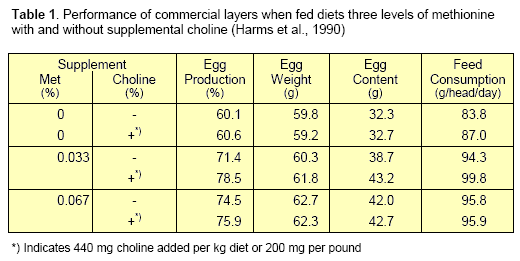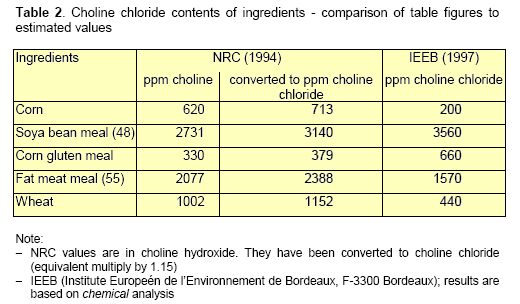



Choline - The Rediscovered Vitamin for Poultry
By H.A. Workel, Th. Keller, A. Reeve and A. Lauwaerts - Choline, formerly known as vitamin B4, has been rediscovered as an indispensable feed additive in poultry. Over the last 3 years more articles discussing the use of choline chloride have been published than in the previous ten. This article aims to summarise recent studies by INRA, France (1997) and the University of Illinois, USA (Emmert and Baker, 1997), as well as the outcome of some previously unpublished research programmes.In the Code of Federal Regulations (USA), paragraph 21CFR 182.8252, choline chloride is a so-called "Generally Recognised as Safe" product. In the European Union, choline chloride is mentioned as a permitted ingredient in babyfood, according to the Directive 91/321/EEG. Annison (1996) has recently summarised the nutritional roles of methionine, choline and betaine, and their inter-relationships. He clearly demonstrated that choline has essential metabolic functions for which neither betaine nor methionine can substitute.
These essential functions are:
- as a constituent of phospholipids, i.e. it is essential in the building and maintenance of cell structure, as well as ensuring normal maturation of the cartilage matrix of bone, including the prevention of perosis in broilers;
- in fat metabolism in the liver, i.e. utilisation and outward transport of fat, so preventing abnormal accumulation of fat within hepatocytes - so-called "fatty liver";
- as a precursor for acetyl choline synthesis, the transmission agent for impulses along the sympathetic nervous system.
Choline Chloride - Dietary Requirements of Broilers
Choline chloride is a common supplement to poultry feed. However, published
dietary requirements are based on studies several decades old and there has been
significant change both in feed formulation and bird performance since these
requirements were established. Hence, recent studies have sought to re-establish
the requirements for choline chloride supplementation of broiler diets.
Emmert and Baker (1997), using a choline-deficient basal diet, showed an almost
linear response to incremental addition of choline chloride up to 1115 mg/kg feed in
chicks from 10-22 days of age (Figure 1). Increasing choline chloride to 2000 mg/kg
resulted in further weight gain improvements, but to a lesser extent. Levels in excess
of this had no benefit. This study is of particular interest since the diet was treated to
ensure inhibition of de novo choline synthesis. The growth responses were therefore
directly related to the dietary choline chloride supplement, assumed to be 100 %
bioavailable. The influence of natural choline and the uncertainty of the bioavailability
of the latter were thus negated.
Another recent study (INRA, 1997) has examined the response to dietary choline
chloride supplementation (0, 400, 800, 1600 mg/kg) in broilers grown to commercial
weights with typical corn/soybean meal based diets. Feed conversion was
maximised at the 800 ppm level, improving from 1.71 (no addition) to 1.66 kg feed/kg
gain. At this level of supplementation starter and grower diets contained 2100 and
1900 mg/kg of choline chloride equivalent respectively. These concentrations are
consistent both with the levels used in the trials of Emmert and Baker (1997) and an
earlier INRA study (1987), and with the recommendation of Larbier and Leclerque
(1982) to add 500-600 mg choline chlorid per kg feed.
The economics of these responses (using INRA; 1997 data) can be calculated thus:
- 1000 kg of liveweight gain requires 1710 kg feed at a feed conversion rate of 1.71 (no added choline chloride)
- 1000 kg of liveweight gain requires 1660 kg feed at a feed conversion rate of 1.66 (addition of 800 ppm choline chloride)
- therefore 50 kg of feed is saved per ton of body weight gain by adding approximately 1.33 kg choline chloride (calculated as 100 %).
Choline Chloride - Dietary Requirements of Layers
Layers, like broilers, have an essential requirement for choline. A major use is in the
formation of the phospholipid lecithin, a component of egg yolk. Current NRC recommendations
for choline allowances in laying hens are 105 mg/day for white egg
layers and 115 mg/day for those laying brown eggs. At feed intake levels of 100 and
110 g/day for the two types respectively, this implies a choline dietary concentration
of approximately 1100 mg/kg.
A number of factors may influence a hen's requirement for choline, for instance age,
feed intake and dietary crude protein or methionine levels. It is generally accepted
that dietary requirement declines with age, possibly associated with an increasing
feed intake. Methionine is the first limiting amino acid for egg production and, given
the common function with choline in methyl group donation, interactions between the
two nutrients may be anticipated.
Several trials have investigated these interactions (e.g. Parsons and Leeper, 1984;
Keshavarz and Austic, 1985; Miles et al, 1986; Harms et al, 1990). Most authors
agree that where diets are low in crude protein and/or marginal in total sulphur amino
acids, responses to both methionine and choline supplementation occur. However,
whilst both nutrients can increase egg production in these circumstances, only
methionine appears to exert a positive influence on egg size (Keshavarz and Austic,
1985). Examination of egg yield data from these various methionine/choline
response studies suggest small, but consistent responses to choline over and above
those achieved by methionine (e.g. Harms et al., 1990; see Table 1). This may be
interpreted as choline exerting a sparing effect on methionine use for methyl group
supply. In the commercial scene with diets highly specified for methionine + cystine
(e.g. 0.7 %), this implies a relatively low requirement for choline supplementation.
Conversely, with lower M + C levels (0.53 %, NRC 1994) choline requirement will be
higher. Harms et al. conclude from their work that in feeding hens at least cost, the
requirement for metabolic methyl groups is best met from choline and that feeds
should contain sufficient choline to provide 118 mg/hen/day.
At a feed intake of 100 g/day, a recommendation of 118 mg choline/day equates to a
dietary requirement of 1180 mg/kg, similar to that advocated by NRC (1994). As
these levels may be only slightly higher than those supplied by the raw materials in a
typical commercial diet, there has been debate about the need for dietary
supplementation with choline chloride. Supplementation may therefore be viewed as
a precaution against variable availability of choline from natural sources. Commercial
recommendations for the choline content of layers feed are in the range 1200-1400
mg/kg (e.g. Leeson and Summers, 1991). Assuming a background level of
approximately 1000 mg/kg, this suggests the dietary supplementation with choline
chloride should be in the range 250-500 mg/kg.
Choline - Natural Content of Feedstuffs
Standard choline chloride contents of feed ingredients, based on chemical analysis
of crops, are given in NRC (1993) tables. However, it may be expected that variation
in content of choline will occur due to variation in prevailing crop growth conditions, e.
g. climate, cultivar, soil, location, fertiliser and spray regime etc. A recent comparison
has been made of choline contents of selected feed raw materials with "book" (NRC,
1994) values (IEEB, 1997). The results, corrected to choline chloride equivalent, are
summarised in Table 2 and significant differences between published and measured
values are evident. However, chemically determined values give no indication of
bioavailability of naturally occurring choline.
Emmert and Baker (1997) have estimated the bioavailability of choline naturally
present in soybean, rapeseed and peanut meals, at 83, 24 and 76 % respectively.
Whilst these figures clearly show the variation in bioavailability of the native choline
in feed ingredients, they also illustrate the problem of referring to book values when
formulating feeds. Rapeseed has a significantly higher choline content than soybean
and peanut meals (6198 ppm versus 2218 and 1685 ppm respectively) but the
availability is less than a third that of the others. This uncertainty of the availability of
natural choline has been well documented. For example, in the study of Marcha and
McMillan (1980), chicks fed a diet apparently sufficient in choline, based on chemical
analysis, still showed significant growth responses to supplementary choline chloride.
Effect of Supplementation of Broiler Diets with Betaine and/or Choline
There have been several statements published recently discussing the use of
betaine as a replacement for choline chloride. Whilst acknowledging that betaine can
replace choline for only one of its biological functions, the broad conclusion from
these articles is that betaine can remove the need for supplementary choline chloride
if the basal diet contains adequate natural choline. However, as stated above, the
availability of natural choline is uncertain. Therefore, to be sure the essential
requirement for choline is met, choline chloride should be added to the feed,
irrespective of the possible attraction of using betaine for other reasons. This reason
can't be the difference in hygroscopicity, mentioned in some articles, because this is
more or less the same for both products.
The effect of supplementary betaine in chicks fed with graded levels of choline
chloride has recently been studied by Emmert and Baker (1997). In these studies a
choline free basal diet was used. Adding choline chloride had an almost linear effect
on growth and feed conversion. The addition of betaine at a concentration of 500
mg/kg feed (equivalent to 591 mg CC/kg) to the basal diet and to diets containing
approximately 570 mg choline chloride/kg feed had no effect at all on bird
performance (Figure 2-4). This neatly illustrates that the essential requirement for
choline must be met before responses to betaine can be expected.
The conclusions from the studies summarised in the present article are:
- the figures of NRC tables for natural choline content of feed raw materials are not always valid and should therefore be used with caution
- the bioavailability of naturally occurring choline varies widely between raw materials which, with variation in absolute levels, means the contribution to dietary concentration may be severely overestimated
- choline is essential for certain metabolic processes and cannot be replaced by betaine for these functions
- adequate choline supplementation will overcome the variation in raw material
concentration, and the uncertainty of bioavailability, supplying both the essential
and non-essential needs of the bird -
the following supplementary levels of choline chloride (as 100 %) are recommended:
- broilers - 500-800 ppm
- layers - 250-500 ppm.
References
List of literature cited is available from authors.


Authors
H.A. Workel, Th. Keller, A. Reeve and A. Lauwaerts - Amersfoort (NL), Ludwigshafen (D),
Cheshire (UK), Ghent (B) (*)
(*) Authors are members of theTechnical Committee of Choline Chloride group within CEFIC, Brussels.
CEFIC is the umbrella organization of the European Chemical Industry.
Questions or remarks should be sent to H.A.Workel.
Telefax: +31.33.4676017 or e-mail: [email protected]
Originally Published: May 2002








